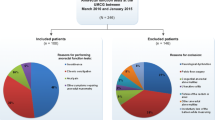Abstract.
Studies of rectal sensory thresholds and compliance in patients with the irritable bowel syndrome have produced conflicting results though there is persistent evidence of rectal hypersensitivity particularly in those with diarrhoea-predominant symptoms. This study examined rectal sensation and compliance in 31 patients with constipation-predominant irritable bowel syndrome (mean age 41 years, 27 female) and 17 healthy volunteers (mean age 45 years, 17 female). A rectal balloon was inflated with fluid at a constant rate and the volume and intrarectal pressure at sensory thresholds was recorded. The volumes at first (129 ± 8 vs 229 ± 24 ml, P < 0.001 Mann-Whitney-U test), constant (159 ± 12 vs 286 ± 21, P < 0.001) and maximum tolerated sensation (290 ± 13 vs 509 ± 19, P < 0.001) were all significantly less in the irritable bowel group. There was no significant difference in intrarectal pressures at any of these volumes (29.0 ± 2.2 cmH2O vs 29.0 ± 2.5, 35.0 ± 2.5 vs 34.0 ± 2.8, 71 ± 2.5 vs 65.0 ± 3.0 respectively). Rectal compliance was significantly less in the irritable bowel group (3.6 ± 0.2 ml/cmH2O vs 8.7 ± 0.4, P < 0.001). Twenty two patients complained of abdominal pain on balloon inflation, mimicking that experienced as part of their symptoms. Patients with constipation-predominant irritable bowel syndrome have rectal hypersensitivity and reduced compliance.
Résumé.
Des études sue le seuil de sensibilité rectale et de compliance rectale chez des patients porteurs d'un côlon irritable ont donné lieu à des résultats contradictoires alors même qu'il persiste de manière évidente une hypersensibilité rectale, en particulier chez des patients présentant des diarrhées comme symptôme prédominant. Cette étude examine la sensibilité rectale et la compliance chez 31 patients dont le côlon irritable se manifeste de manière prédominante par une constipation (âge moyen: 41 ans, 27 femmes) et chez 17 volontaires sains (âge moyen: 45 ans, 17 femmes). Un ballon intra-rectal est distendu avec un liquide à vitesse constante et on enregistre le volume et la pression intra-rectale pour des seuils de sensibilité déterminés. Les volumes de perception initiale (129 + 8 vs 229 + 24 ml P < 0.001 au test Mann-Whitney-U), les volumes pour une perception constante (150 + 12 vs 286 + 21, P < 0.001) et les volumes pour des seuils de tolérance maximale (290 + 13 vs 509 + 19, P < 0.001) sont significativement abaissés dans le groupe des côlons irritables. Il n'y a pas de différence significative dans la pression intra-rectale à aucun des volumes donnés (29,0 + 2,2 cm H2O vs 29,0 + 2,5, 35,0 + 2,5 vs 34,0 + 2,8, 71 + 2,5 vs 65,0 + 3,0 respectivement). La compliance rectale est nettement abaissée dans le groupe de côlon irritable (3,6 + 0,2 ml/cm H2O vs 8,7 + 0,4, P < 0,001). Vingt-deux patients se plaignent de douleurs abdominales lors de la distension du ballonnet semblable à la douleur constitutive d'une partie de leurs symptômes. Les patients présentant de manière prédominante une constipation en liaison avec leur côlon irritable ont une hypersensibilité rectale et une diminution de la compliance rectale.
Similar content being viewed by others
Author information
Authors and Affiliations
Additional information
Accepted: 17 December 1996
Rights and permissions
About this article
Cite this article
Slater, B., Plusa, S., Smith, A. et al. Rectal hypersensitivity in the irritable bowel syndrome. Int J Colorect Dis 12, 29–32 (1997). https://doi.org/10.1007/s003840050074
Issue Date:
DOI: https://doi.org/10.1007/s003840050074




